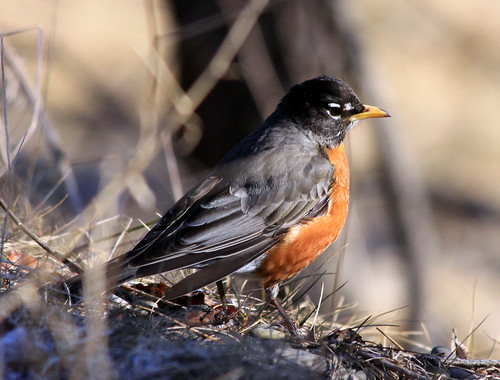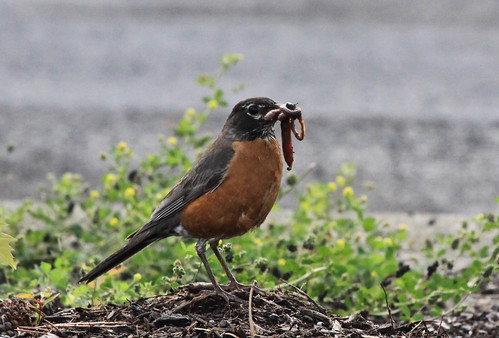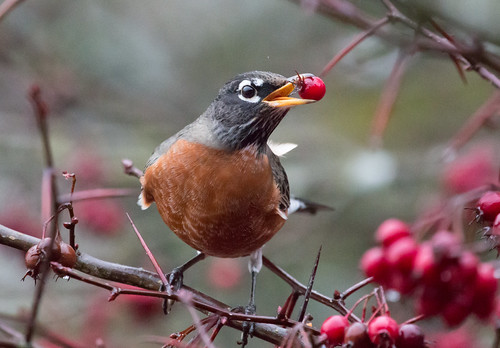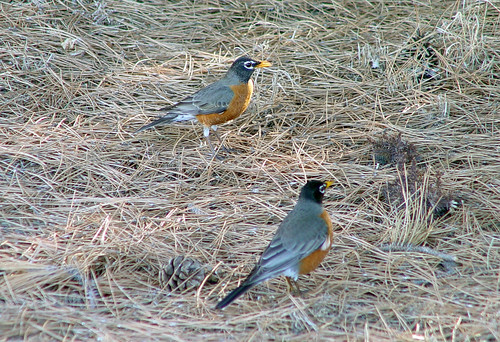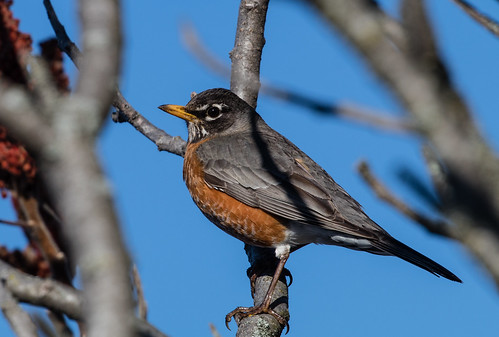Unfortunately for straightforward storylines, robins don’t move between two separate ranges for summer and winter. They can be found year-round in coastal Alaska and British Columbia as well as at least a bit of all the northernmost states extending into Canada. I’ve personally seen robins on the Grand Marais Christmas Count as well as on a lot of Duluth Christmas Counts. “The first robin of spring” is hardly a ridiculous concept, but it is a complicated one that requires nuance to explain.
Robins are one of many species that switch their diet and lifestyle as well as their range between summer and winter. We think of robins as eating earthworms, which they certainly do, in addition to a whole host of insects, during their nesting season.
They eat worms and bugs during migration and winter, too, as they find them. But overall, they feed much more on fruits from fall to early spring each year.
Their behavior shows a dramatic change when they arrive where they'll nest, and both male and female grow extremely territorial. After they're done raising young for the season, they'll grow extremely gregarious until the next year.
So we could think of winter robins as flocking frugivores and breeding robins as territorial worm-eating insectivores. To simplify that, the first robin of spring would be performing its most territorial act—singing—and running on lawns eating worms.
But there isn’t a simple on-off switch between the two seasons. It’s more of a dimmer switch that takes many days or weeks to move all the way from off to on. Through winter, robin sex organs are excess baggage—like most birds, their testes and ovaries shrink after the breeding season, swelling up again in response to increasing day length and weather conditions. During the time those sex organs are expanding in early spring, the birds start producing sex hormones, at very low levels at first, and peaking as they establish their territory and start nesting behaviors.
When I’ve gone down to Nebraska in March to watch Sandhill Cranes, I’ve seen huge robin flocks pigging out on old crabapples and running in brown grasses along the edges of marshes looking for worms.
And I’ve occasionally heard individual robins singing while still associating in flocks. They usually sing more quietly than on territory, and quickly get chased by other robins that are starting to feel their oats enough to be stressed hearing their song. I’ve frequently seen squabbling between males in these late winter flocks that I hardly ever see in January or early February. Little by little, the flocks break up even as they follow roughly the 37-degree isotherm northward.
That 37-degree isotherm is another complexity. That’s roughly the average day-night temperature at which earthworms start emerging. But warm underground springs here and there can make worms available when the average air temperature is quite a bit colder, and in areas that didn’t get much snowfall despite frigid temperatures, soils may not thaw enough for earthworms to emerge for many days after that temperature threshold is reached. So again, the rule is a general one.
During a good spell of mild weather in late March or April, my own backyard male robin will arrive and start singing away—HE’S my first robin of spring. A week or so later, one wonderful morning, I’ll spot a female with him. They’ll squabble with any robins who come near my yard, especially defending my backyard birdbaths as their personal property, yet for weeks after they’re both back being fully territorial, I’ll be seeing flocks of robins still passing through and still acting like winter robins. Every step of the way, the hormonal levels of those migrating robins will be rising, and some will be squabbling with one another and some males will start singing and other males will give chase. Using robins to define the start of spring is like watching the snow melt in March and declaring winter is over—late snow storms and late winter robin flocks are two reasons there's an April Fools Day.
So how do you distinguish between the “first robin of spring” and the “last robin of winter”? We simple-minded humans have trouble comprehending complexities. Fortunately, robins have an easy time wrapping their bird brains around this kind of complexity. They'll have no trouble knowing exactly what to do as our long-awaited spring finally unfolds.
